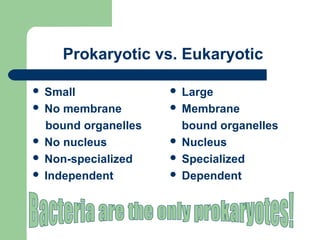Cell presentation
- 1. Cells- The Basic Unit of Life Presented By: Mrs. Nelson
- 2. Cell Theory All living things are made of cells. Unicellular: single cell ex) bacteria, protists Multicellular: many cells ex) animals and plants Cells are the smallest working units of living things. All cells come from pre-existing cells.
- 3. Prokaryotic vs. Eukaryotic Small No membrane bound organelles No nucleus Non-specialized Independent Large Membrane bound organelles Nucleus Specialized Dependent
- 4. Explains the origin of eukaryotic cells. What is the main difference between prokaryotic and eukaryotic? Simple Complex (prokaryotic eukaryotic) Chloroplast/Mitochondria have own DNA Scientists suggest that this means these organelles were once lived independently outside of cells
- 5. Controls what enters and exits cell Semi-permeable Also known as phospholipid bilayer
- 9. Allows cells to talk to one another Important for multicellular organisms Cells send “messages” to one another Messages = hormones Ex.) Histamine
- 10. Gives your cells “identity” = id card Distinguishes your cells from other cells Immune system
- 11. Allows molecules to pass through the membrane
- 12. The Cell Factory The cell is like factory… Factories produce something… Cells produce proteins… Different cells produce different proteins… People / machines perform functions in a factory. “Organelles” in cell work together to make the protein.
- 13. Cell Membrane Door to the factory. Controls what enters/exits the cell.
- 14. Cytoplasm Jellylike substance where the organelles found…
- 15. The Nucleus “Control Center” – in charge of all the cells activities Contains the DNA or chromosomes DNA is instructions for cell to build proteins Nucleolus- makes ribosomes
- 16. Mitochondria “Generator of the cell” Supplies cell with energy Change food energy into energy cell can use (ATP- gasoline)
- 17. Chloroplast “Power Station” Found only autotrophic organisms Contain pigment chlorophyll Trap sunlight convert it into energy
- 18. Ribosomes “Assembly line workers” Proteins built
- 19. Endoplasmic Reticulum “Highway” system Materials can travel on it throughout the cell Rough ER vs. Smooth ER
- 20. Golgi Apparatus “Packaging Center” Collects, modifies, packages proteins and other molecules made in the cell
- 22. Centrioles “Reproductive Structures” – organize cell division. Always in pairs and found only in animals cells.
- 23. Vacuoles “Storage Areas” Store materials such as: water, wastes, and nutrients
- 24. Animal Cell
- 25. Plant Cells
- 26. Contrast Plant Cells Cell wall and cell membrane chloroplast and mitochondria LARGE Central vacuole NO- centrioles “square” shape Animal Cells cell membrane ONLY mitochondria two more small vacuoles centrioles “round” shape
- 27. Human Cheek Cell (Animal cell)
- 28. Elodea Cell (Plant Cell)



























